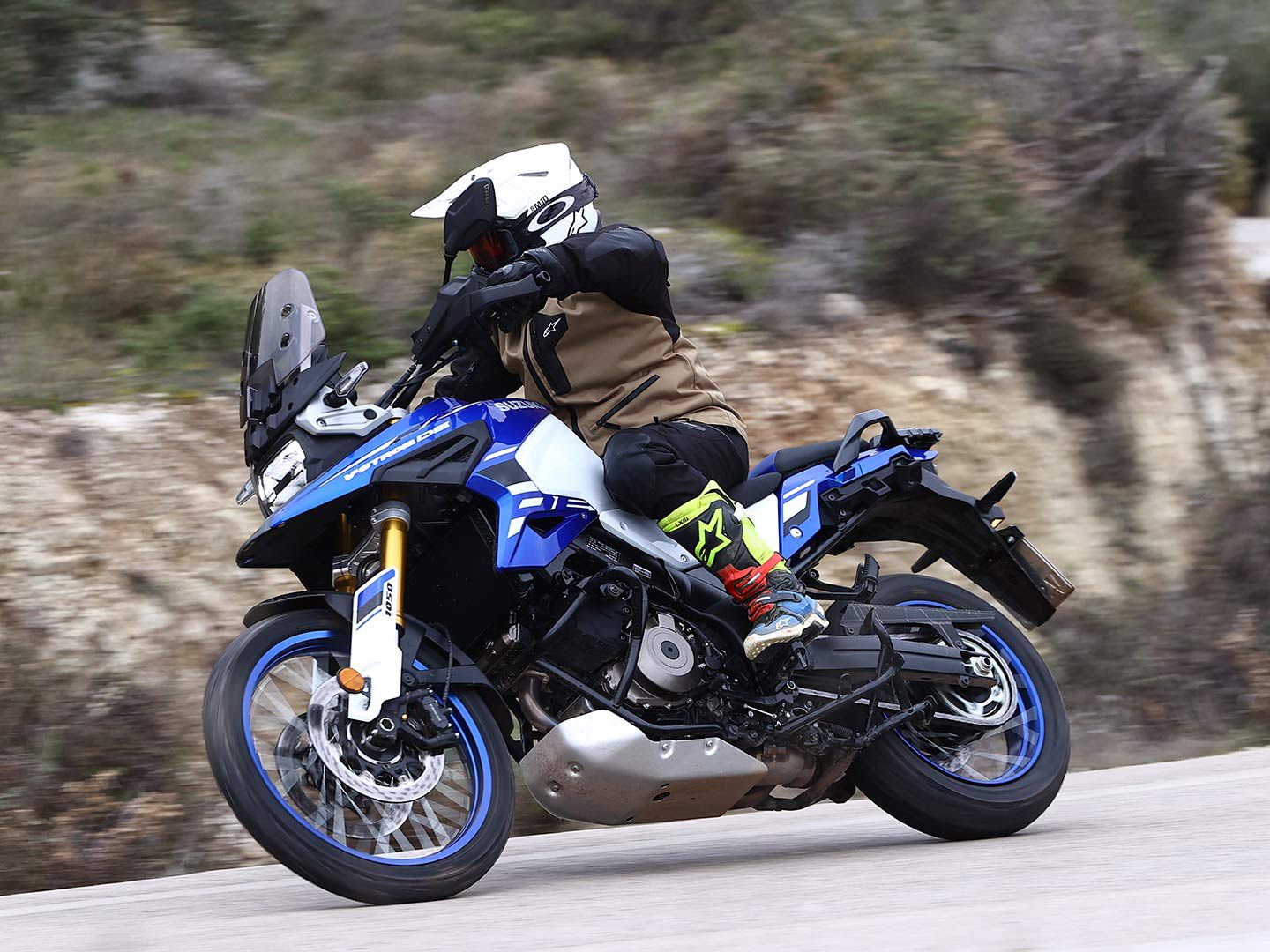
Suzuki hasn’t set the powersport world on fire in recent years. As other manufacturers churn out ever-more niched and technically advanced new motorcycles, the Hamamatsu factory seems content to plod along with modest machinery.
Editor’s note: we test rode the previous XT version during the 2020 Suzuki V-Strom 1050XT Review MC Commute article and video.
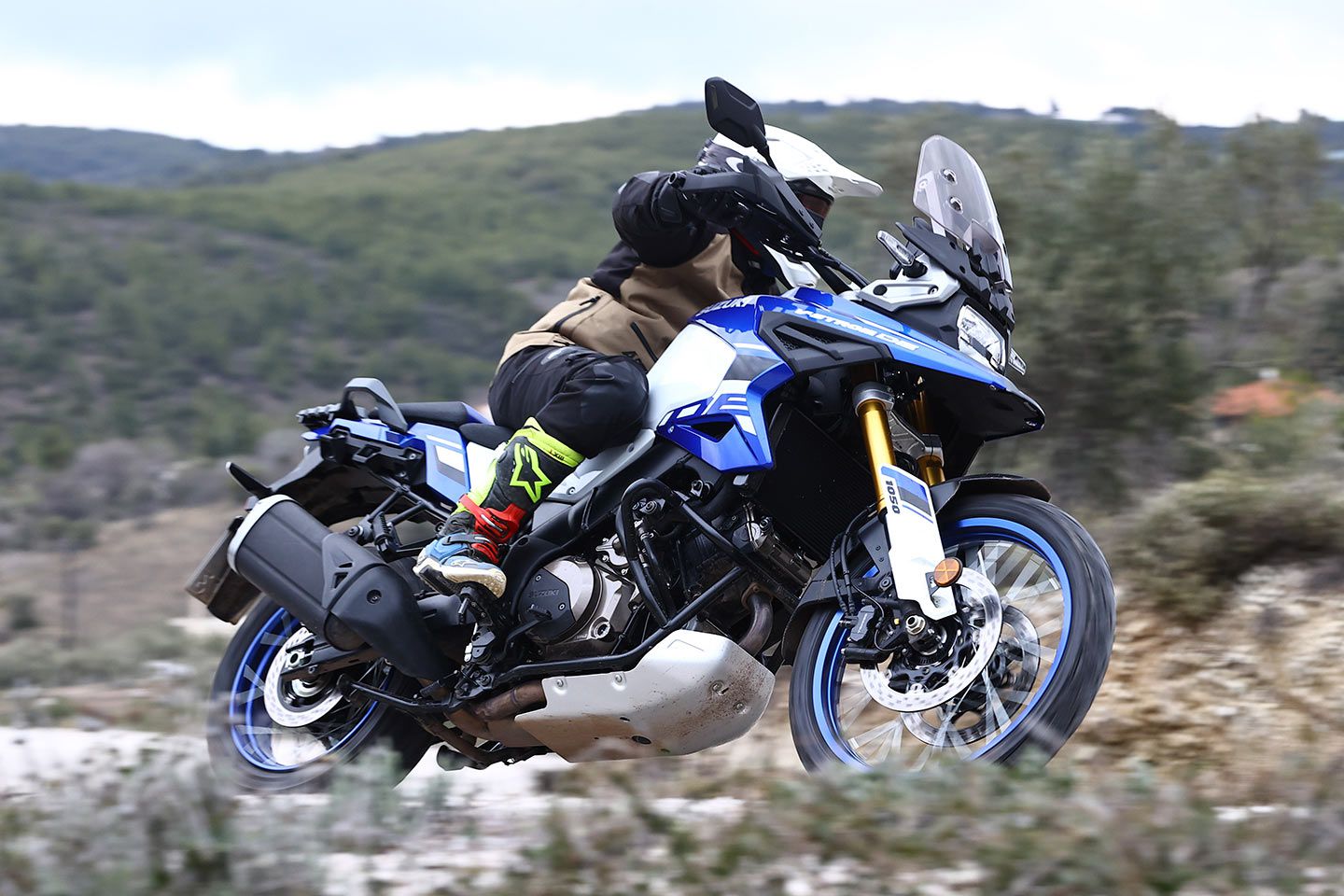
The GSX-S1000GT sport-tourer and GSX-S1000 sport naked can’t compete with Ducati or BMW or even KTM’s offerings on the spec sheet while the aging V-Strom dynasty looks decidedly frumpy ranged against the Multistradas, Adventures, and GSs of this world.
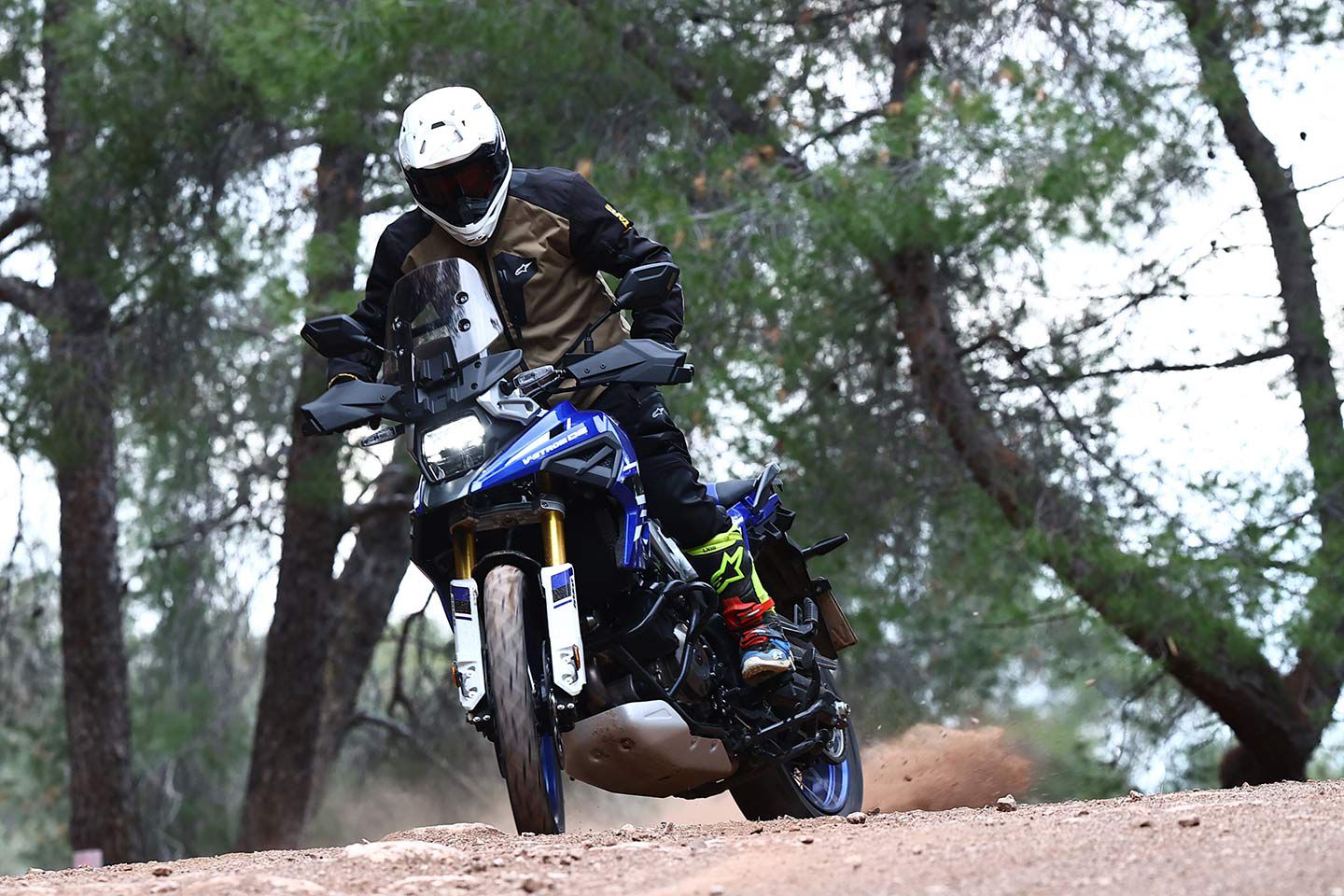
Suzuki may not offer as much choice or cutting-edge technology as the market lusts for these days, and the yellow bikes may also lack the desirability of the European competition especially. But it does a job—and at a fair price. And for thousands of riders across the globe, that’s enough, thank you.
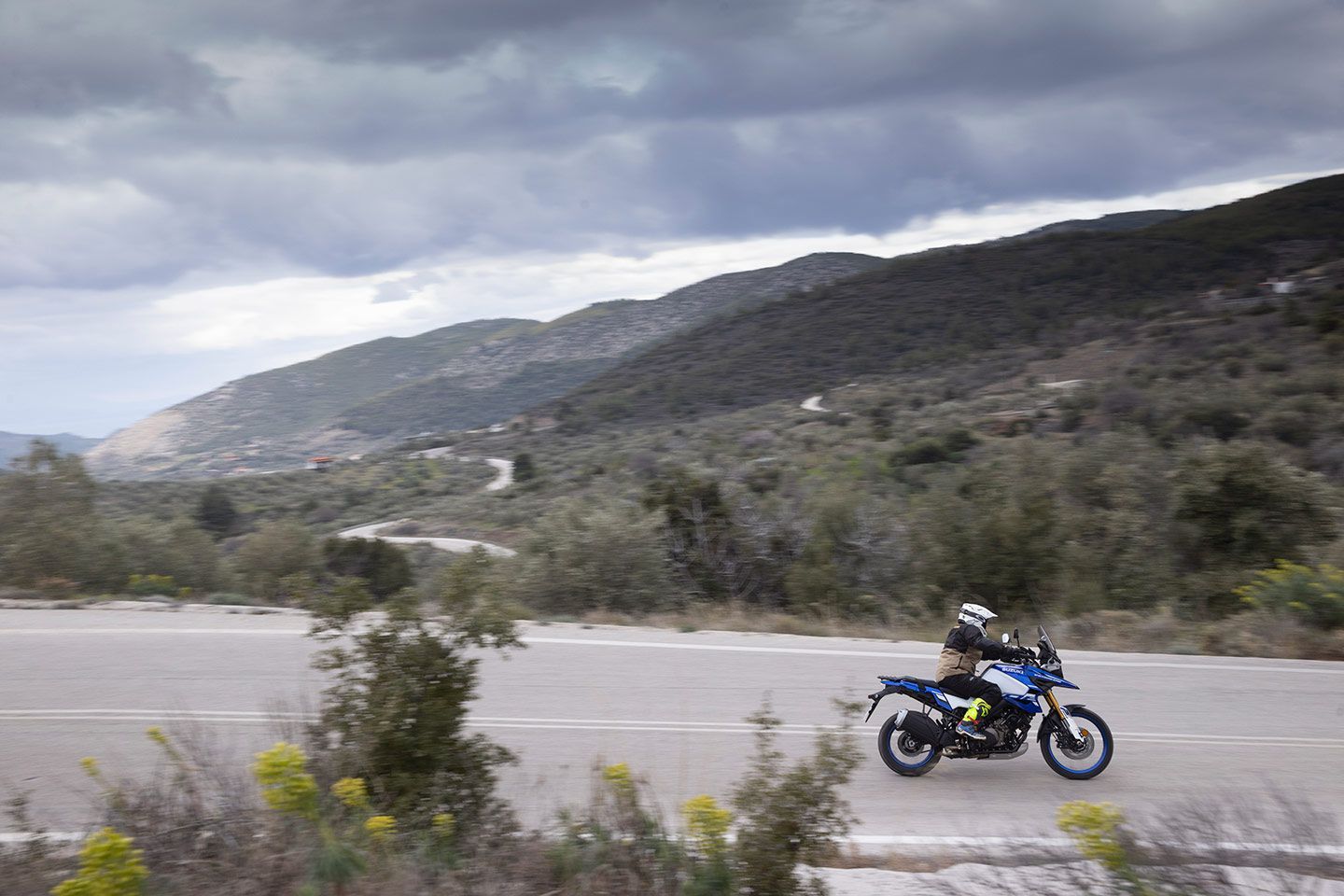
Take the V-Strom 1050DE, Suzuki’s adventure stalwart. It’s not the critic’s favorite, perhaps, but take a ride out on a Sunday and you’re likely to see a V-Strom or two parked up at the local bike-friendly hangout. We like them. They are out there, doing a job.
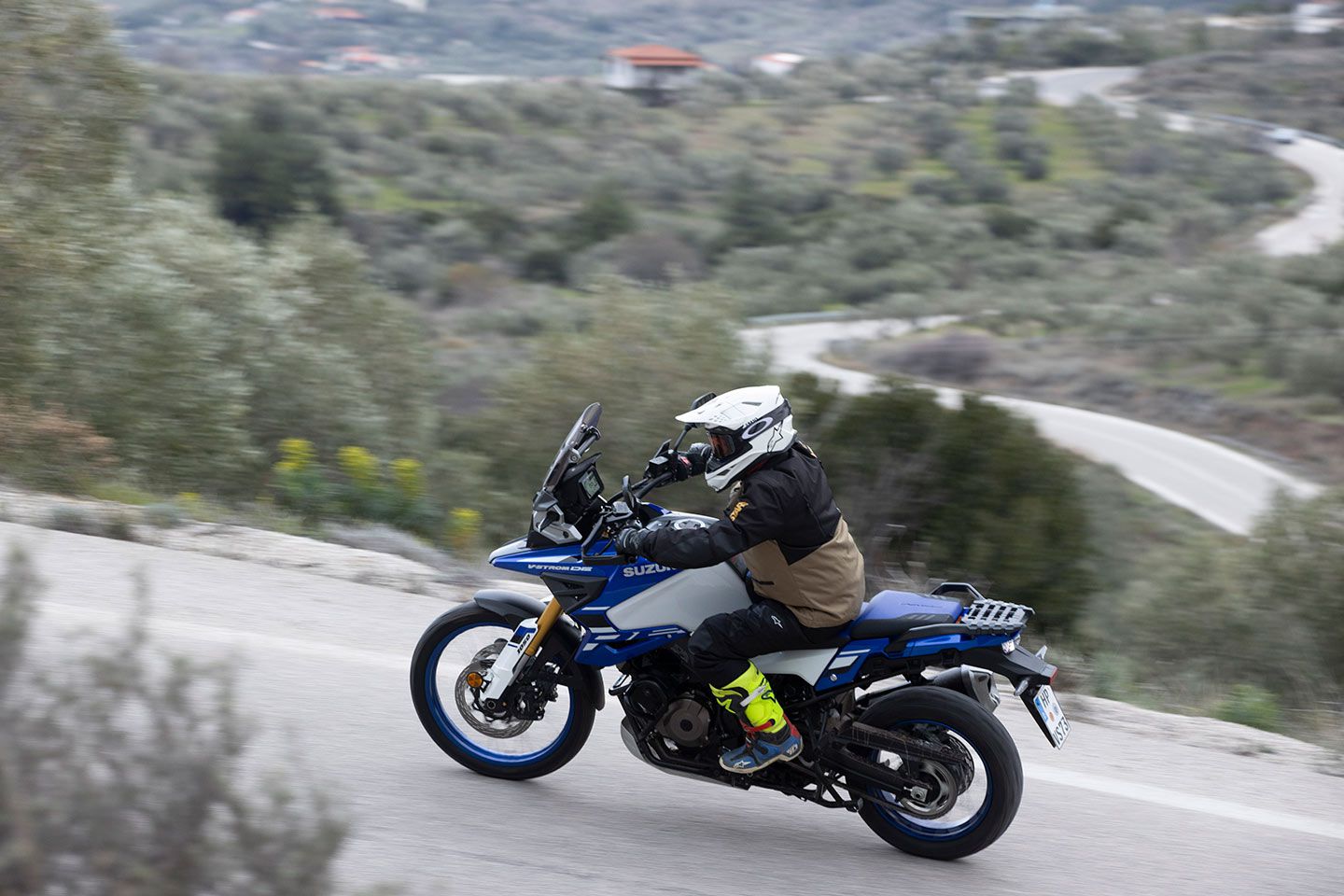
The V-Strom first appeared in 2002 and is without question the unsung workhorse of the adventure market; the dependable goalie who quietly does their work behind a freewheeling team of far more glamorous centers and wingers.
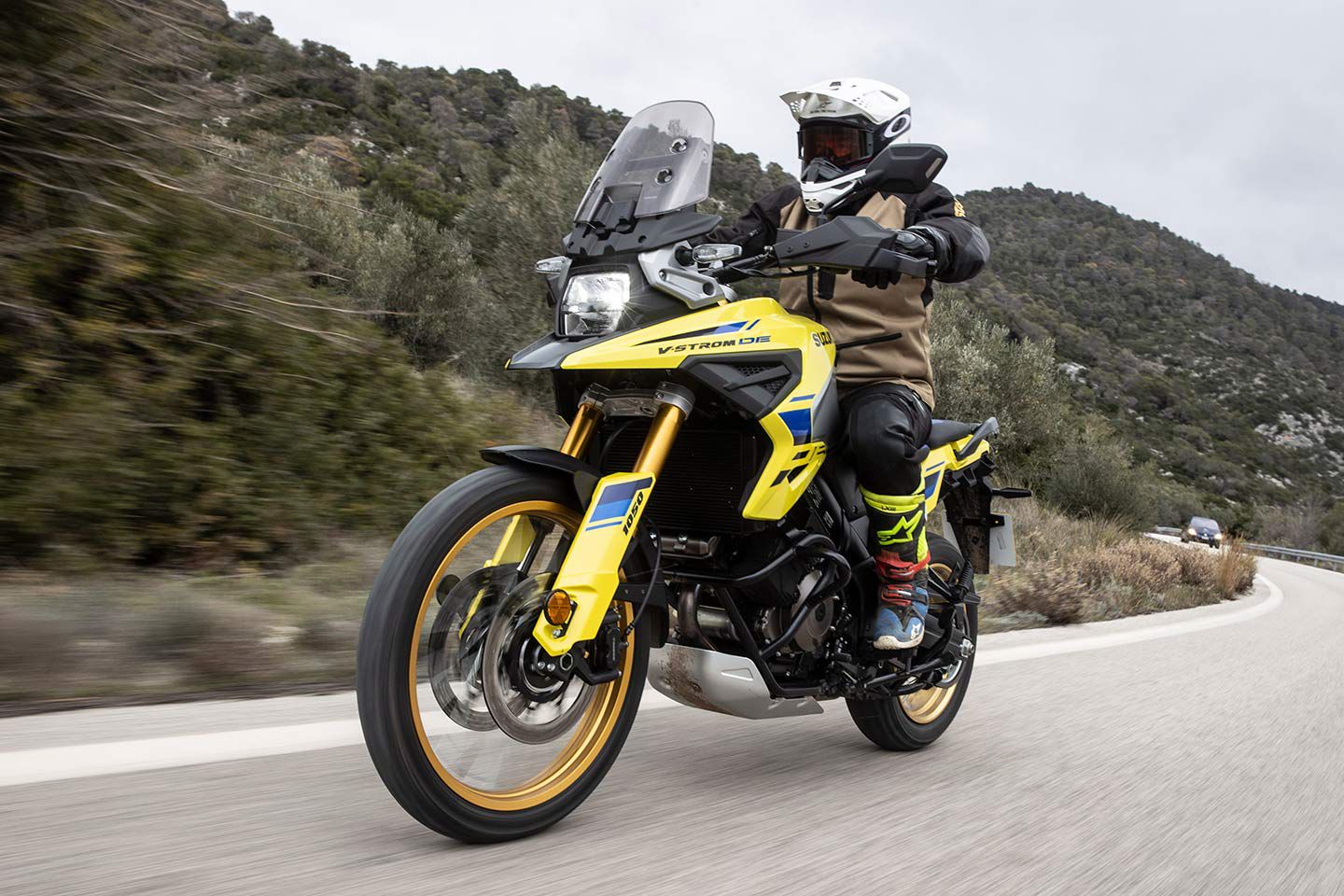
It’s easy to see why it has remained so popular. Robust, easy to ride, relatively straightforward, and with just enough rider aids for most, it has retained a price-competitive position throughout its 20-year run. A top-spec Multistrada V4 S will set you back a little over $27K while the Suzuki DR1050DE Adventure can be had for $17,599. That’s a saving equal to several memorable trips away, and a head-to-toe riding kit refresh too.
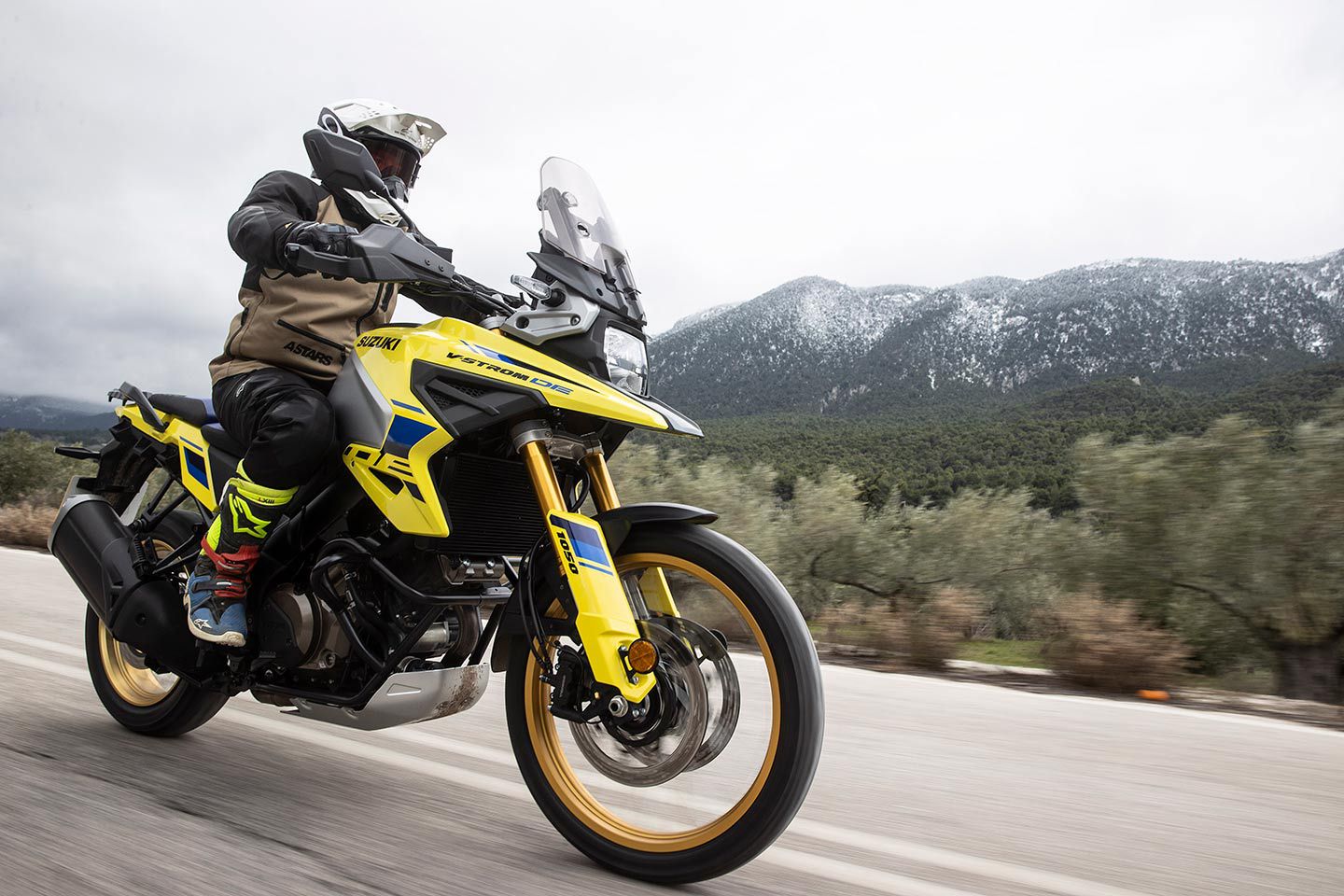
As enduring and trustworthy as the big V-Strom has been, Suzuki knew its flagship adventure bike was missing something—an X-factor beyond its price point to help it meet the competition toe-to-toe. Well, that’s changed now because finally, it has produced a machine with off-road ambitions—the new 2023 1050 DE.
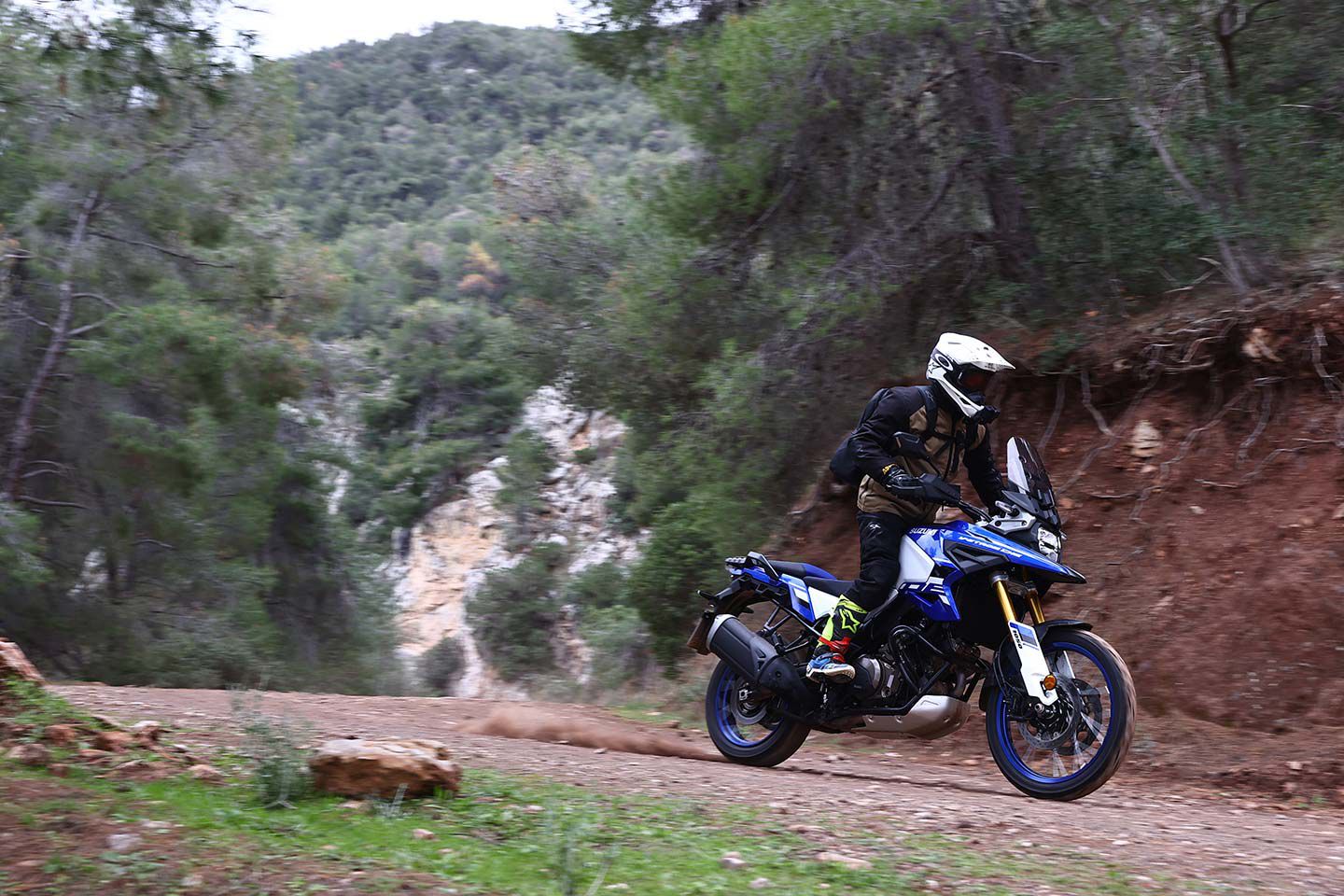
The 1050 DE is the Japanese factory’s fourth-generation V-Strom. Yes, it has the familiar water-cooled 1,037cc V-twin platform which, in concept at least, can be dated back to Suzuki TL1000S from the late ‘90s and produces precisely the same peak power and torque—106 bhp at 8,500 rpm and 73.7 lb.-ft. of torque at 6,000 rpm—as the old model, but the changes elsewhere are significant.
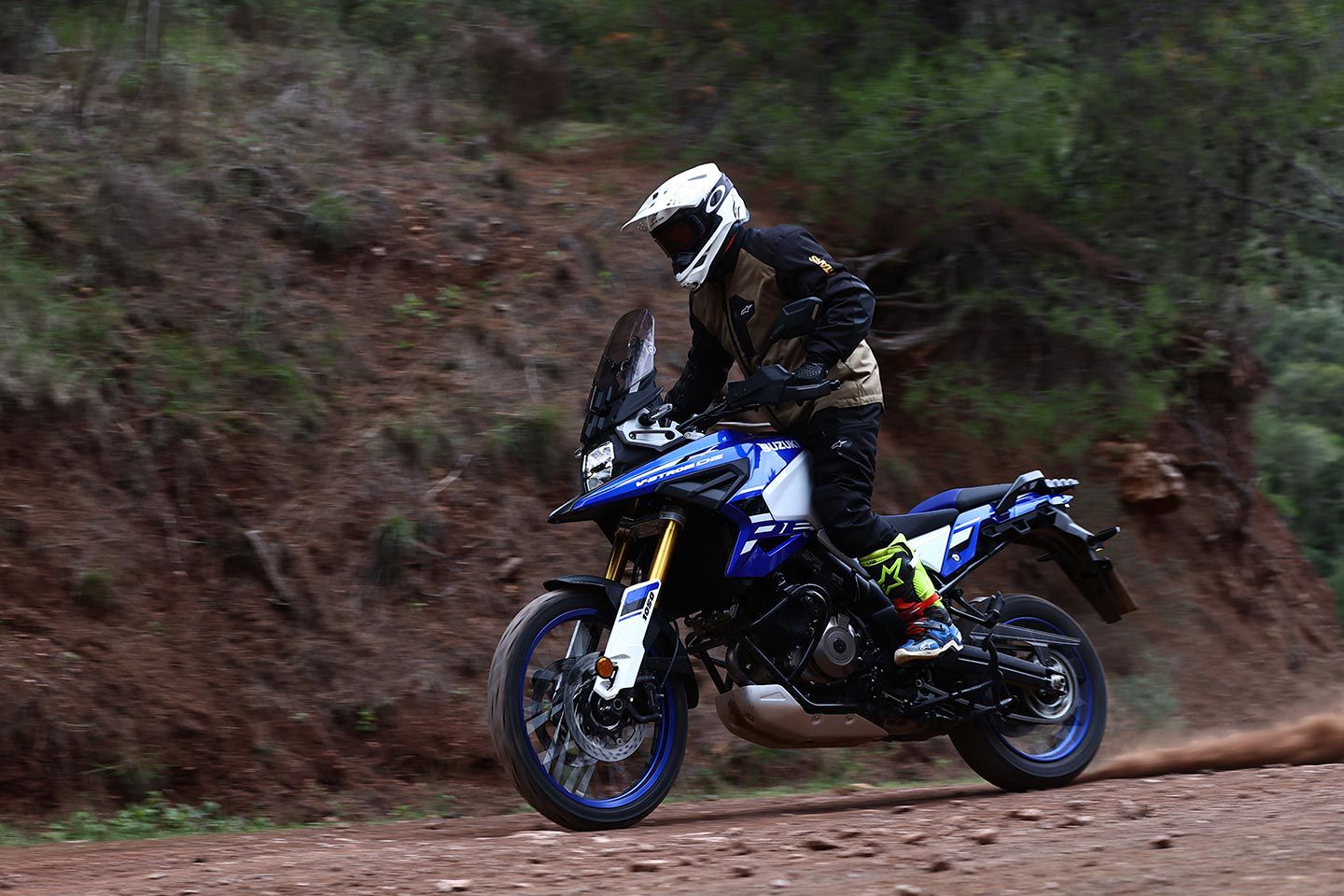
The DE chassis received a major transformation with the introduction of a 21-inch (steel spoked and alloy rim) front wheel, a first for the V-Strom. The headstock is new, the chassis geometry is more relaxed for dirt riding, with increased rake, a longer wheelbase, longer-travel suspension, more ground clearance, and wider bars. Its dirt intentions are clear.
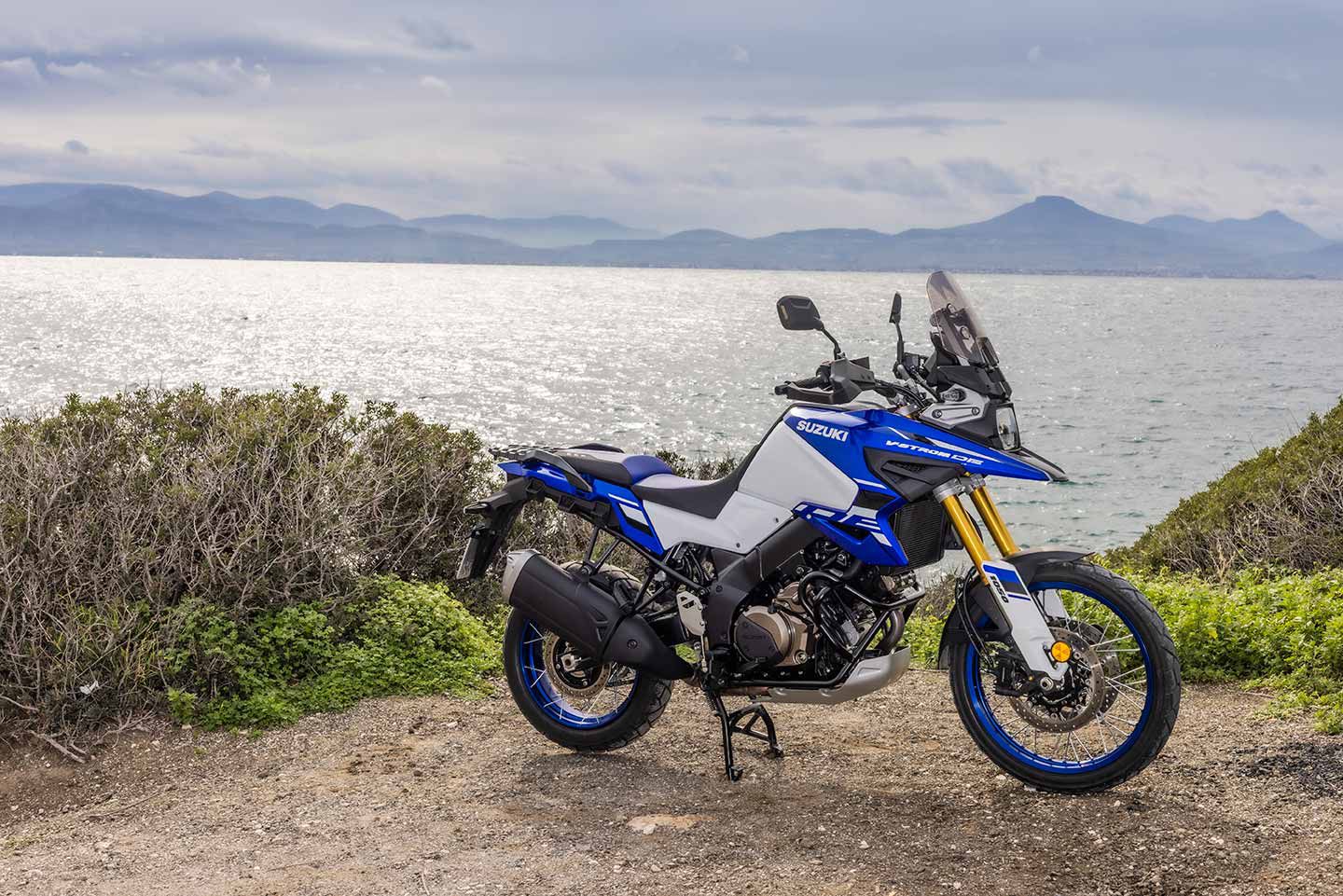
There’s a move from 41 teeth on the rear sprocket to 45, a huge jump and a simple way to make a bike feel livelier. Internal gear ratios have also been modified and combined with a new bidirectional quickshifter to add even more zip to the relatively low-powered unit.
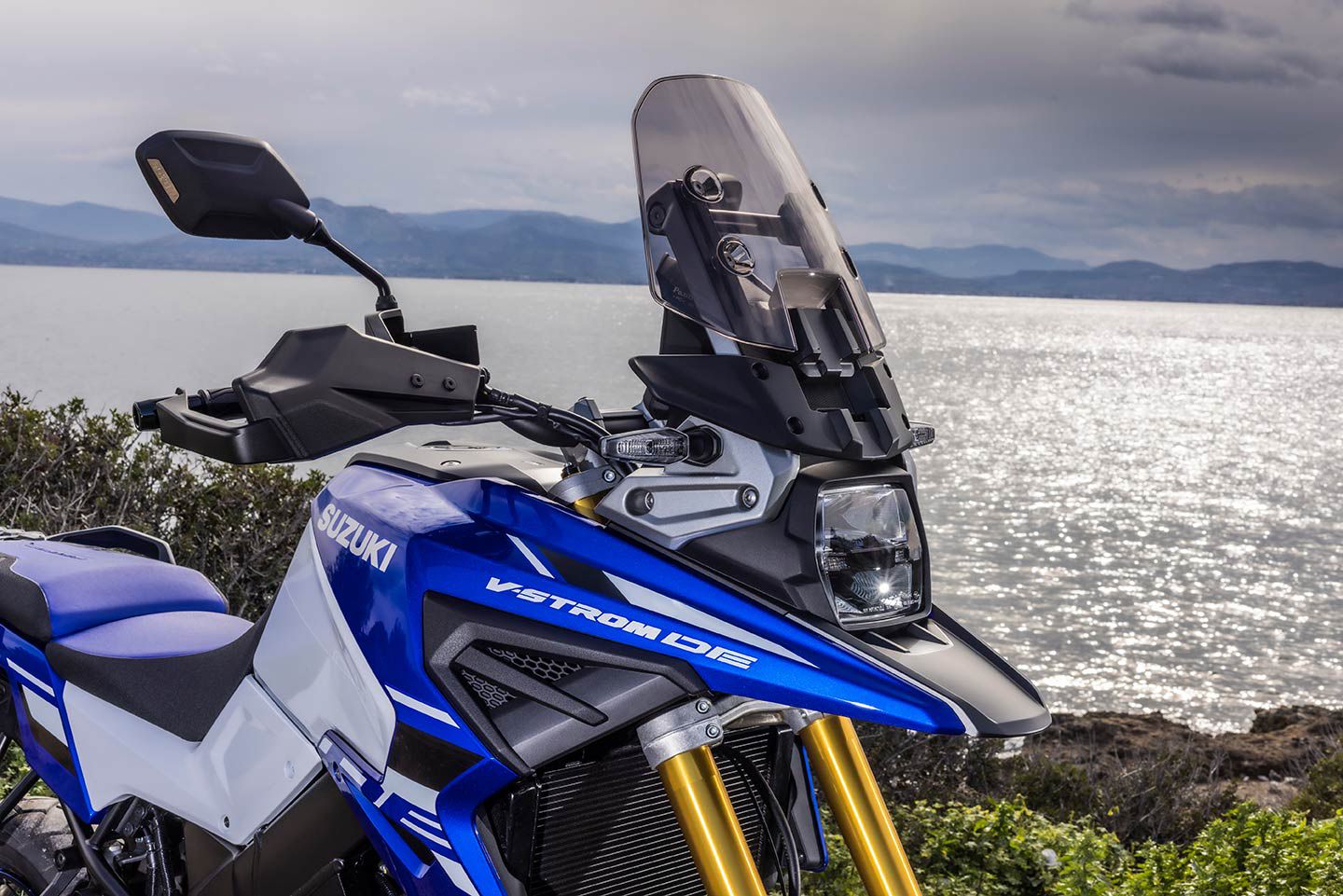
The electronics have been upgraded on the DE, most notably in the shape of a neat 5-inch full-color TFT dash. Power modes remain the same—there’s an A, a B, and a C mode—with each altering the torque and throttle characteristics. Lean-sensitive ABS and TC remain the same as before but get more adjustments, including a new Gravel mode and switchable rear ABS.
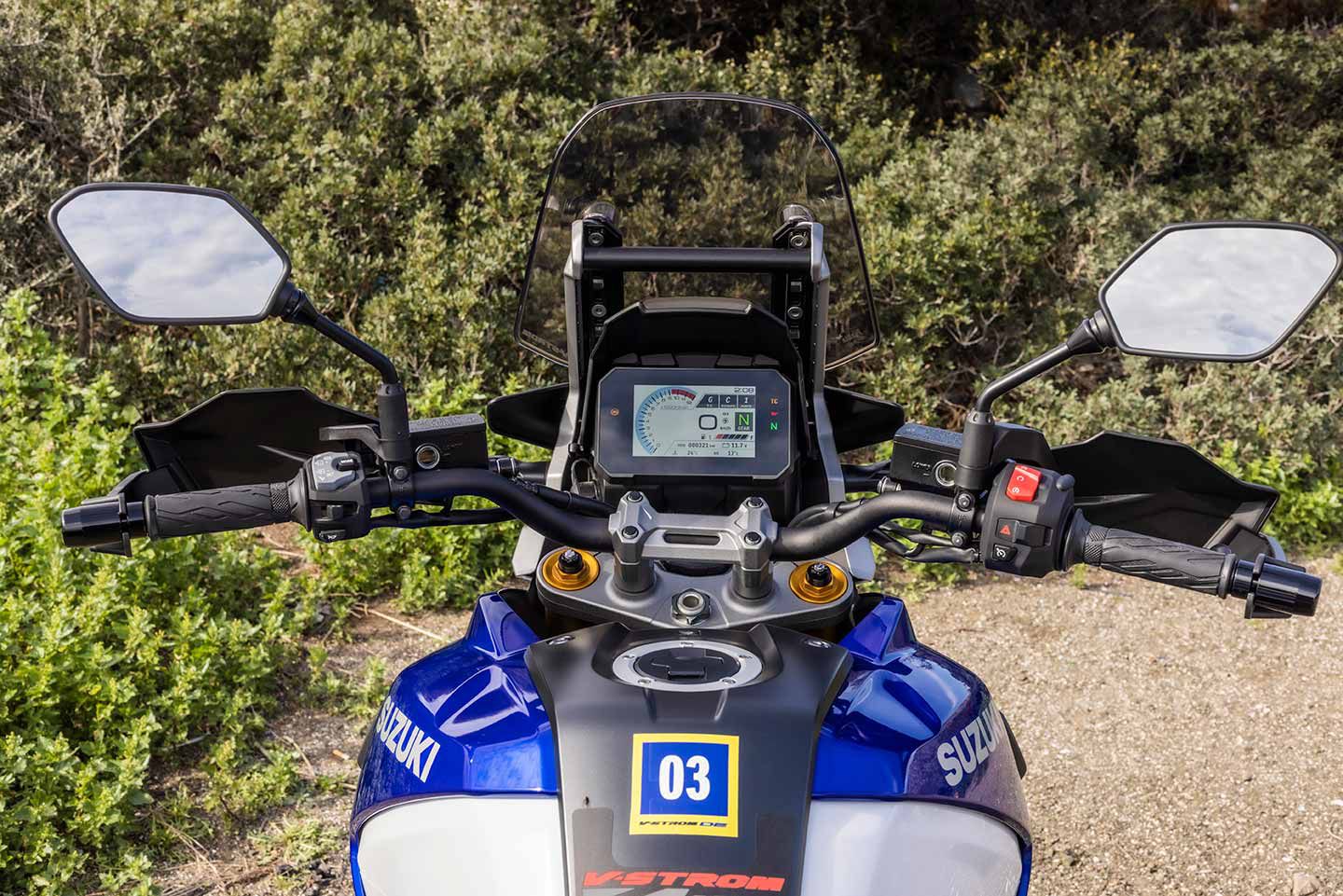
Cruise control comes as standard and again has been revised for 2023. The DE also gets a smaller nonadjustable off-road screen, wider pegs with removable rubbers, and the front mudguard is slightly higher to give more clearance for mud and gravel. Longer-travel suspension also means the seat height is higher in the new DE: 34.64 inches compared to 33.66 inches on the standard 1050.
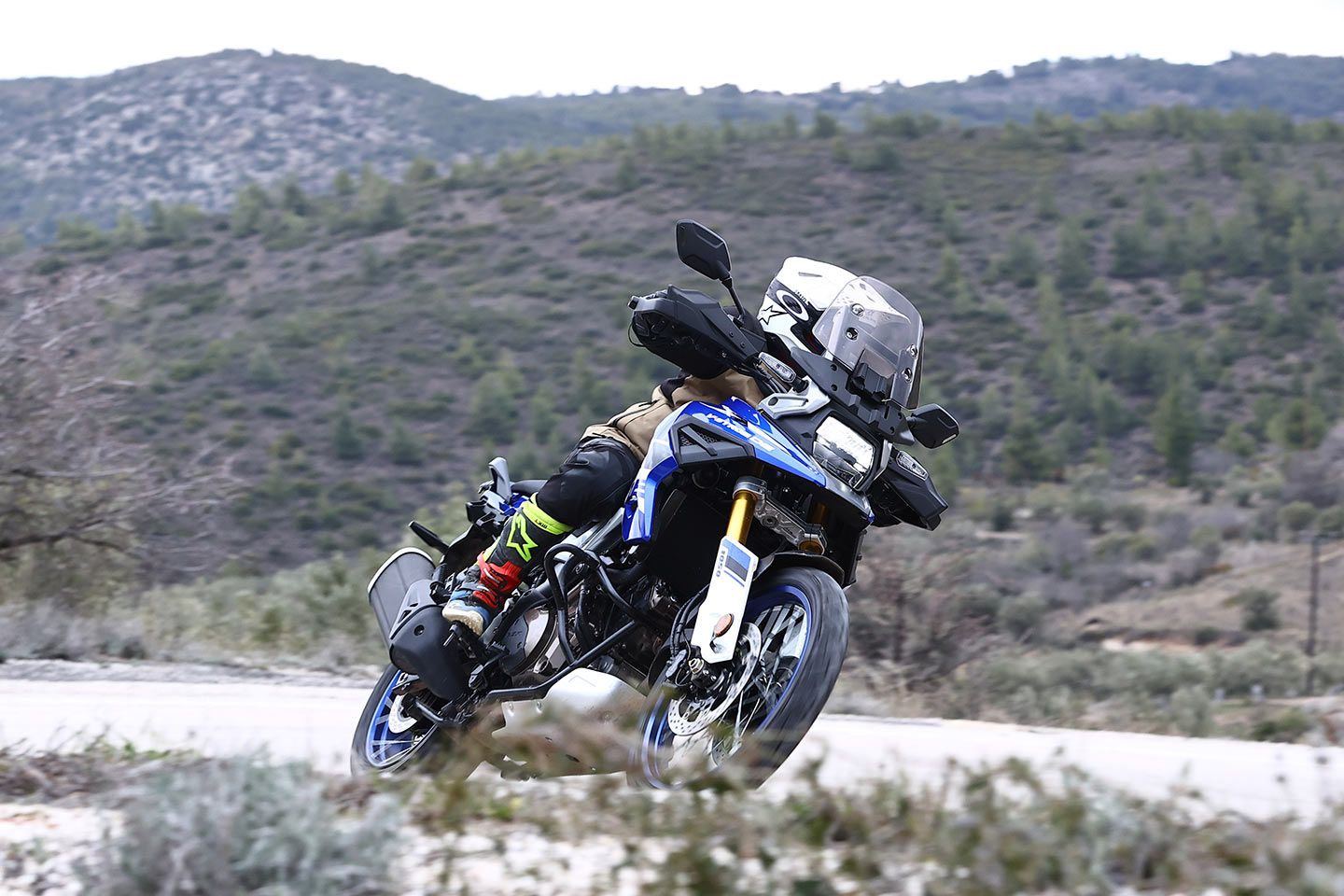
So while Suzuki hasn’t reinvented the wheel with the new V-Strom DE, it has given it the tools to carry on when the asphalt expires.
The good stuff continues when you jump on board. That new display is clear, legible, and like the switch gear, easy to use. The perch is on the high side, as you’d expect from a long-travel, 21-incher adventure bike. The standard 1050 seat sits between 33.7 and 34.4 inches, but the DE is fixed at 34.6 inches. I’m 5-foot-7 (172 centimeters) and, wearing stiff enduro boots with little ankle movement, struggled at times, and would recommend the 1.2-inch-lower seat option for shorter riders.
This taller riding position is noticeably more focused than both the older DE model and the standard 2023 1050. The bars are now 1.6 inches wider and that fixed, off-road-biased screen is 3.1 inches shorter and narrower while the pegs, with removable rubbers, are wider. All of this lends the DE a bigger, more dirt-biased stance, but even as a small rider, I felt comfortable.
Suzuki chose Greece as the venue for this first test of the DE and riding through narrow urban streets on our way out of town, the V-twin felt as friendly as ‘Stroms of old. But there was also something new.
The fueling is as clean and friendly as ever, but now, especially in the imaginatively named A mode, there’s an extra zip in performance. While the V-twin may produce exactly the same torque output through the revs as the older ‘Strom, lowering the final gearing has given the Suzuki a welcome punchiness when you open the throttle, and injects new energy into what is a relatively weighty adventurer.
Turn off the TC—which you can easily and intuitively do on the move—and the DE will happily loft its new 21-inch wheel, something I wasn’t expecting on a long-wheelbase machine that tops the scales at 554 pounds. On the switchbacks that took us high into the hills, the DE cast off its slightly dull image and rewarded me with a fun and exciting ride, the up-and-down quickshifter adding an unlikely sprinkling of sportiness.
It’s not a total transformation, of course. There are limitations to what can be achieved with a change to the final drive ratio. And when you compare the V-twin’s 106 bhp and 554 pounds to the Honda Africa Twin 1100 (113 bhp and 505 pounds with a full tank of gas) or Ducati DesertX (110 bhp and 492 pounds), it brings home how much extra bulk the Suzuki continues to carry.
Those extra pounds are constantly there in the background; I was always aware of how much heavier it feels compared to its more modern class rivals. It’s not a massive hindrance, especially for stronger and larger riders, but it is noticeable. Fast direction changes require more rider input through those wider new bars and, while stability is not in question, you would never describe the DE as agile either. The longer wheelbase, large front wheel, and more relaxed steering head angle haven’t helped, but carve up a mountain pass at speed and you’ll soon work up a sweat.
Suspension travel has increased to 6.7 inches up front and 6.6 inches on the rear, but not to the usual 9.1 inches (front) and 8.7 inches (rear) combination you’d normally associate with a 21-inch front wheel adventure bike. In normal or brisk riding, the KYB fully adjustable 43mm fork copes with the weight of the V-Strom, and the rear, with remote preload and rebound damping adjustment, offers a secure ride. Overall, the ride is on the soft side and more suited to comfort for everyday riding and touring rather than anything aggressive.
Cool conditions during the test didn’t encourage overly sporty riding—nor did the tires. Suzuki has opted for slightly unusual rubber and sizes: a 21-inch Dunlop Trailmax Mixtour up front, with a tube, and a 17-inch Trailmax Mixtour on the rear, which is tubeless. Most adventure bikes with dirt ambitions use a 21-inch/18-inch combination, and while I’m sure the cold temperatures didn’t do them any favors, I never got the confidence to push the handling to a peg-scraping angle of lean. Warmer weather, though, may change all that.
Like the V-Strom’s engine and suspension, the brakes, too, are capable rather than inspiring. Cornering ABS comes as standard and has two road levels, plus the new off-road setting which simply deactivates the rear ABS and a load-dependent braking system that modulates ABS intervention. This means that, in theory, if you add weight such as luggage or a pillion or both, this changes the ABS intervention as you’re asking more of the brakes, pulling the lever harder. Braking is also linked, the front lever activating the rear, but not the other way around, as the rear pedal is independent of the front. To add to the list of marketing-led terminology, the Suzuki has Slope-dependent Control System which, simply put, prevents the rear lifting and stoppies.
On the test ride in Greece, I had no serious issue with the Tokico stoppers, and ABS intervention was only felt on the rear on the slippery surfaces we encountered. I would expect 90 percent of V-Strom owners to have no complaints but, again, the bike’s weight problem raises its ugly head. After all, 556 pounds (including fuel) plus a rider, possibly a pillion and luggage as well represents a sizable mass and a lot to ask of the front stoppers. The DE certainly isn’t over braked.
Suzuki’s V-Strom has always scored highly when it came to churning out miles, and the new DE should continue that tradition. Cruise control is standard and can now be set at lower speeds, although I’m not sure anyone sets their cruise control to lower than 30 mph. The riding position is roomy and the shortened screen does a decent job. Hand guards are standard, as is the USB port on the left side of the dash, while under the seat is a 12-volt DC outlet. As mentioned, the new dash is clear and far easier to navigate than much of the competition. Heated grips, fog lights, and full luggage are available as accessories.
Of course, the big question is whether Suzuki has genuinely improved the off-road ability of the V-Strom. And the answer is yes, unquestionably. Riding cautiously on mixed, easygoing terrain, the Suzuki rolled across all that was thrown its way with composure.
As the pace picked up, however, the suspension bottomed out and lacked control, and suddenly I was all too aware of that excess weight. Trying to stop 554 pounds on a steep and slippery downhill felt challenging rather than fun. This isn’t a bike you can easily pop over rocks and small obstacles, either; attempt an ambitious maneuver and the DE feels like it’s being forced to do something it doesn’t really want.
Furthermore, the Gravel riding mode doesn’t act as a true rider aid by preventing slides but simply remaps the throttle to reduce power delivery, so you can’t rely on it to save you as you might on the DE’s competitors. It’s useful, however, to now have the ability to deactivate the rear ABS, even if the front ABS hasn’t been calibrated for serious off-road abuse and is simply the same as on the road.
All said, I enjoyed the ‘Strom off-road; its wider bars, soft suspension, and fueling worked well together, and it’s relatively easy to ride as long as you don’t take on anything too challenging. On light trails the Suzuki DE can certainly scratch that weekend itch for off-road adventure.
In essence, the ‘Strom is engaging in a robust and trustworthy way—just as it always has been—and now it’s more versatile than ever with some off-road ability. If you don’t look too closely at the competition, it is hard to fault.
However, the competition can’t be ignored. At $17,599 there is some strong competition out there, with a higher spec than the Suzuki, like Triumph’s Tiger 900. Honda’s standard Africa Twin is lighter, more powerful, and has more gadgets. My favorite in this class is the Ducati DesertX, which is incredibly capable both on and off-road and only a fraction less than the Suzuki ($17,695).
The 2023 V-Strom DE carries all the great qualities of the older bike along with more off-road potential, but now over $17K it’s up against some stiff competition.
2023 Suzuki V-Strom 1050DE Adventure Technical Specifications and Price
| PRICE | $17,599 |
|---|---|
| ENGINE | 1,037cc, DOHC, liquid-cooled, 90-degree V-twin; 4 valves/cyl. |
| BORE x STROKE | 100.0 x 66.0mm |
| COMPRESSION RATIO | 11.5:1 |
| FUEL DELIVERY | Fuel injection; ride-by-wire |
| CLUTCH | Wet, multiplate |
| TRANSMISSION/FINAL DRIVE | 6-speed/chain |
| FRAME | Twin-spar aluminum |
| FRONT SUSPENSION | 43mm KYB inverted, fully adjustable; 6.7 in. travel |
| REAR SUSPENSION | Single KYB shock, preload and rebound adjustable; 6.6 in. travel |
| FRONT BRAKES | Radially mounted Tokico 4-piston calipers, twin 310mm discs w/ Cornering ABS |
| REAR BRAKE | Nissin 2-piston floating caliper, 260mm disc w/ Cornering ABS |
| WHEELS, FRONT/REAR | Wire-spoked wheels w/ aluminum rims; 21 in./17 in. |
| TIRES, FRONT/REAR | Dunlop Trailmax Mixtour; 90/90-21 / 150/70-17 |
| RAKE/TRAIL | 27.0°/5.0 in. |
| WHEELBASE | 62.8 in. |
| SEAT HEIGHT | 34.6 in. |
| FUEL CAPACITY | 5.3 gal. |
| CLAIMED CURB WEIGHT, | 554 lb. |
| WARRANTY | 24 months |
| CONTACT | suzukicycles.com |
Source: MotorCyclistOnline.com
